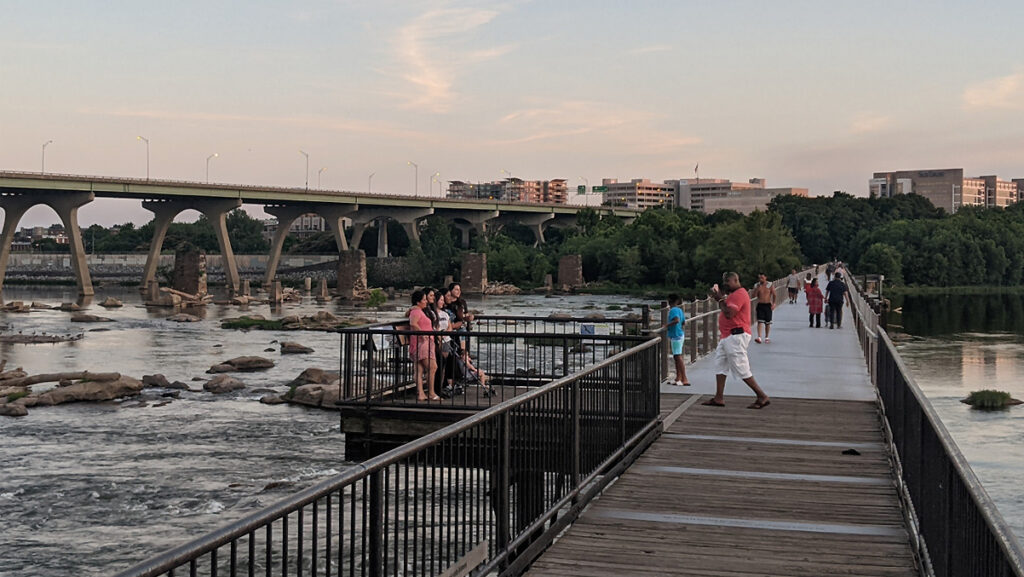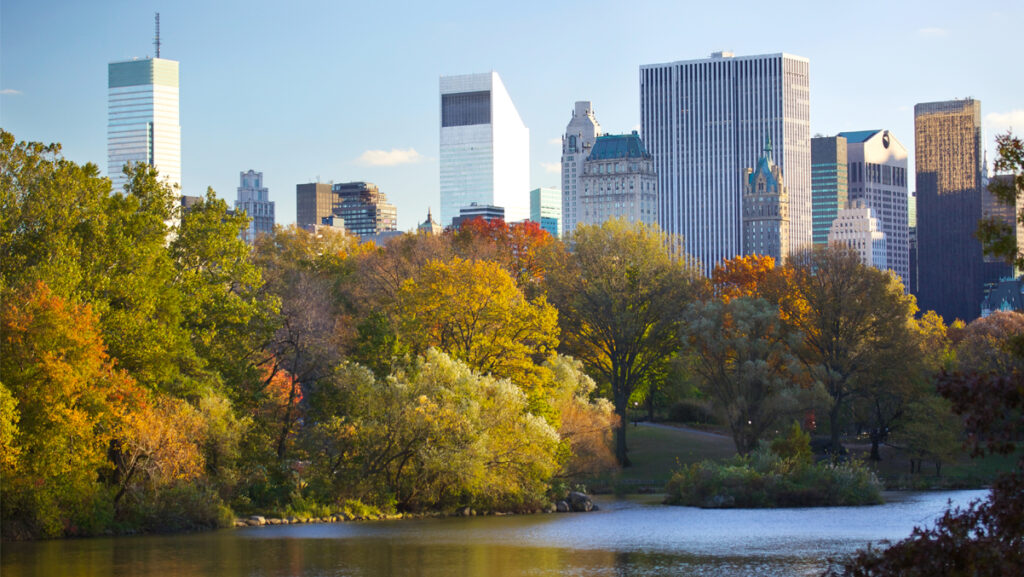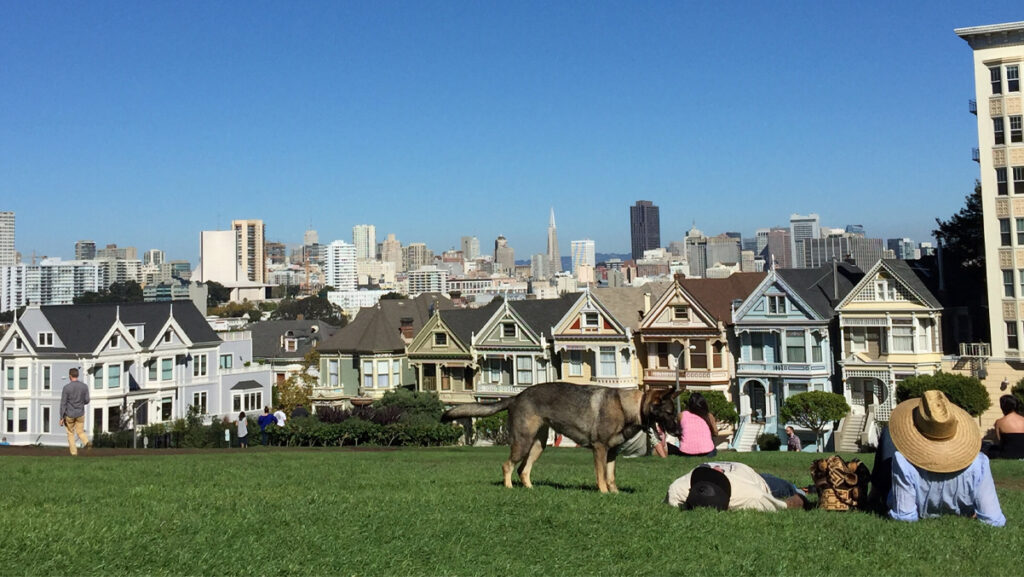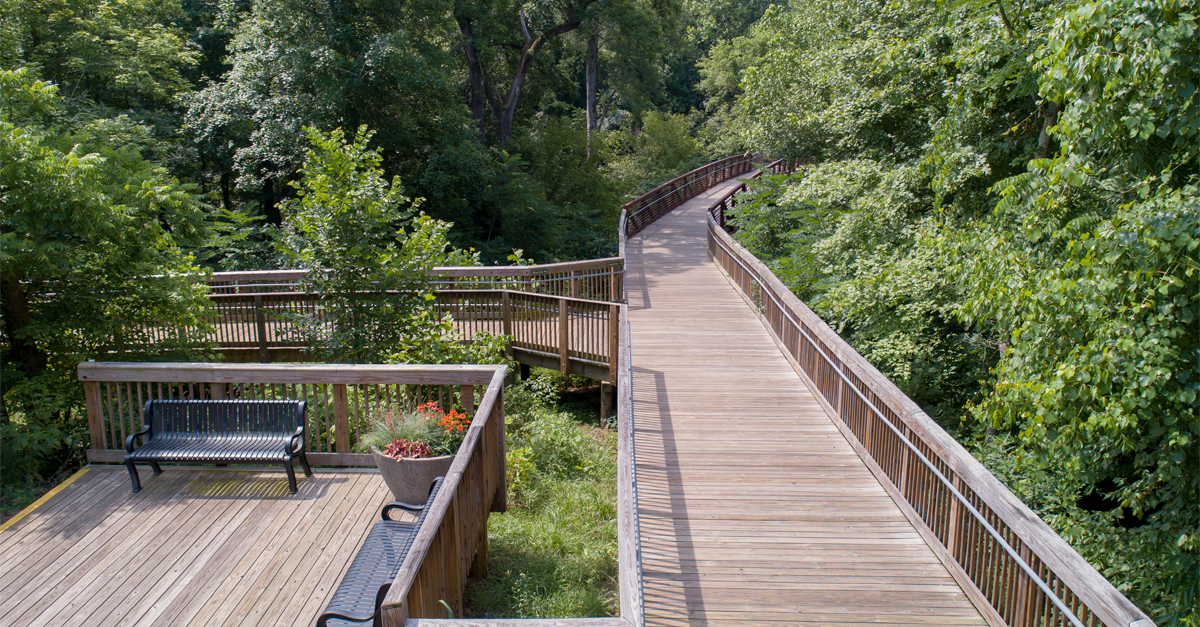Why Do People Go To Parks?
You’re walking down a street on a hot summer day. Your brow is sweating, your face is red, and your feet are aching. Having been outside for much of the day, you’re looking forward to getting out of the heat, but alas—there are no trees in sight.
It’s then that you happen to come across a park, settled in the middle of the community. Its shady, friendly solace beckons to you. You walk in, pick a bench or nice square of grass to sit on, and enjoy a few minutes of peace in your day. This is one of the many services that parks provide to citizens every day. Beyond offering a place to rest and unwind, parks bring many other benefits to our communities, including financial, environmental, and social. Their services to our population cannot be overstated.
However, not everyone is able to enjoy the peace of a park in their community. In many ways, the struggle to ensure everyone has access to a park is a microcosm of how our elected officials, community leaders, and citizens are beginning to address and solve inequity in urban areas. It’s not an easy job, and there are many challenges to solving it effectively.
For this blog, we are using our expertise to address why people go to parks, why every community can benefit from them, and how we can ensure easy park access for all.
Why Does Everyone Need Access to a Good Park?
The answer to this question has filled pages of books for the past century. People go to parks for many reasons—to exercise, to unwind, to take a break, to get some fresh air—but the perks go beyond these simple, healthy activities. We have separated the benefits into four categories: health, financial, environmental, and community wellness benefits.

Lake Rogers Park Boardwalk in Creedmoor, NC
Environmental Benefits of a Good Park
Parks are areas for free play and exercise.
Parks give people a space to focus on their physical health with little to no cost. They allow everyone to improve their physical well-being in a safe, natural area, whether walking, playing, hiking, running, doing yoga, or anything else. Because most parks are freely accessible to the public, they are a great alternative to paid gyms and other locales that require an individual to spend money.
Parks, and public green spaces, mitigate the urban heat island effect.
Urban areas with more heat-absorbing surfaces, such as concrete or asphalt, have a higher ambient temperature than areas with more greenery, parks, or open space. This is known as the urban heat island effect. According to the EPA, the temperature difference can be as much as five degrees Fahrenheit between neighborhoods with green space and those without it in cities.
Parks also reduce ground-level ozone.
Having a higher ambient temperature also traps ozone pollution closer to the ground, resulting in more respiratory problems or asthma for residents. Imagine walking to work, the store, or your car surrounded by smog and heat. Greenery and parks are a more straightforward way to negate both effects while beautifying an area, removing potential airborne pollutants, and increasing overall air quality.
Parks are an opportunity for animal life to find refuge in urban areas.
People go to parks to experience the natural world around them. As we see development matching population growth, parks are a way for displaced animal life to find refuge and maintain ecosystems. Properly designed parks capitalize on the natural features of the environment to provide a sustainable, resilient recreational space that preserves diversity and ecological health. Environmental diversity is critical to sustainable environments, and parks create a safe place for people and animals to coexist.
Interconnected parks create nature highways.
As part of protecting animal life, having connected park spaces prevents environments from becoming isolated. This practice maintains biodiversity. Parks are an excellent opportunity to provide interconnected green spaces that benefit people and wildlife as they move from park to park. Of course, this requires more advanced planning to ensure these connections are not cut or changed. Furthermore, naturally occurring plants and animals should be prioritized when creating green infrastructure.
Parks function as natural stormwater controls.
As areas become less porous because of roads, concrete, and homes, the threat of flooding and pollution due to storms or runoff becomes more prevalent. Stormwater and runoff must be channeled safely into the ecosystem to prevent this. Even a small park can filter and control rainwater so that it returns safely to the groundwater systems, rivers, and streams. Nature perfected this process over thousands of years—it’s a process that’s hard for even our best stormwater engineers to beat.

T. Tyler Potterfield Memorial Bridge in Richmond, VA
Financial Benefits of a Good Park
The presence of parks elevates property values.
Many studies have shown that homebuyers will spend more money to be closer to a park than not. This phenomenon is known as the proximate principle, and its evidence of the high demand for green spaces in our cities. Among workers in the tech industry or those who work from home, parks are increasingly valued because of the desire for people to go to parks to disconnect from their work and home lives. Higher home values lead to a larger tax base for communities to draw from.
Parks can serve as sites for community events.
Parks can serve as areas for concerts, festivals, fairs, craft shows, and more, giving local businesses a chance to make more revenue or draw more tourists and consumers out. These events are often cheap—sometimes free—which opens the opportunity up for more members of the community to attend, benefiting businesses‘ visibility and potential sales.
Parks also create jobs.
Parks are employers as well. Depending on the park’s size, they can create jobs and opportunities for people in the community to start their careers in park management, maintenance, or other recreation-focused professions. They can be home to educational and training centers as well. Furthermore, businesses near to parks or who attend events hosted within parks often need to hire additional employees to keep up with the foot traffic and demand.

Central Park in New York City, NY
Community Wellness Benefits of a Good Park
Parks are vital spaces for social and community interaction.
Parks create space for people to meet, socialize, and hang out for free. This unique niche is important to people of all ages, as many other common locations to hang out limit time or require money to utilize. They help develop a sense of community within a community. Parks provide an opportunity to meet and connect for people who may not be guaranteed as much interaction in their home or work life (such as the retired or the self-employed).
Well-maintained parks lower crime rates in communities.
There is a popular misconception that parks can lead to higher crime rates, but recent research has shown that parks can actually lower the risk of crime. When a park is well-maintained, it encourages positive interactions between community members. It sends a signal that someone is watching over it. When a community is invested in caring for it’s amenities, it is less likely to allow degradation and disuse.
Sometimes the misconception about parks leading to higher crime will lead communities to take steps to discourage crime in parks, such as fencing them in or limiting entry. It turns out, these same steps can have the opposite effect and can deter the positive benefits of parks in general. Not only that, limiting park maintenance or investment in high-crime areas creates a deficit for all community members.
A well-maintained municipal park signals to communities that their leaders are investing in their community’s appearance and well-being.
This is not a statistically measurable effect, but it can make a difference in a community’s relationship with its leaders and its own identity. Especially in areas that have historically been neglected, focusing on parks can be a first step in reversing historical trends of disinvestment, providing underserved populations with amenities that serve their communities and the environment.
Parks and Equity in a Community
While these benefits are great, communities only benefit from parks when everyone can access them. This is not always the case. Historically, it has been common for affluent (and primarily white) communities to have the largest, most well-maintained parks. How did that happen?
Budgeting for parks is challenging.
Municipal budgets are tight. Municipalities have many projects to address to keep their constituents happy, from road improvements to facility maintenance and more. Parks are not always the top priority, and it can be a challenge to set aside funding for a park when other concerns come first. Likewise, some communities have larger budgets than others because the budgets are sustained by tax revenue. In those situations, there may be money ‘left over’ to support park maintenance. This leads to some areas (larger ones, wealthier ones, etc.) having ‘better’ parks than others, and it can be a struggle to find a good middle ground for park development and maintenance.
Historically, separate but equal policies prevented parks in non-white areas from being as well developed and maintained.
Our planning department has looked at historic comprehensive plans which demonstrate how separate but equal was not equal at all. Influential areas were given more funding for parks, more designated space for parks, and more general greenery throughout their neighborhoods. Parks outside of these communities were smaller, less green, and less maintained.
The impacts of those decisions still reverberate in our communities long past the design of those plans. Today, we see how under-served and under-represented communities generally tend to have far less greenery, including landscaping, parks, and open green space. This contributes to the urban heat island effect and ground-level ozone levels in those areas. Furthermore, when the community does not have safe, maintained green spaces, less people go to parks, which leads to the idea that the community is not benefiting from them.
The good news is that more municipalities and governing agencies recognize these historical inequities in green space and combat them by redeveloping parks and reallocating funds. However, the intention to do good is not always enough. This leads us to our next point.
The methods to design for communities do not reach all community members.
In the past, it was not unusual for design firms to decide what a community needed without consulting the community at all. The experts came in, surveyed, determined, and designed. We see this in parks within communities that do not reflect the community’s culture or needs.
In a general design industry culture change, designers and municipal leaders try to meet communities where they are to hear their feedback on community improvements. However, those intentions do not have an equal impact, and frequently, the members of under-served and under-represented communities are the least heard. In our experience, we have seen greater success in reaching these communities when the following practices are used:
- Holding the meeting in an area that is easily accessible to community residents
If the meeting is not held in a central, public location within the community (a library, a church, etc.), residents could have difficulty reaching it or feeling comfortable within that space. The location should also be freely accessible to prevent monetary concerns. - Ensuring the meeting place is within the realm of public transit
If you are trying to reach a community that does not have access to personal transit, then where you go should be accessible via public transit. An even more helpful tactic is providing tickets or funds to residents who come to the meeting via public transit. - Broadcasting the meeting’s purpose and location throughout the community
Meet community members where they are so they know what to bring to the meeting. Make connections within the community with leaders that can help bring the community together. Ensure that everyone knows when, where, and how to reach the meeting. - Thinking out of the box, to reach people who usually aren’t met
Considering community members who don’t work 9-5 on weekdays means you have to plan your meetings to suit their potential work hours. If you are holding a virtual meeting, you could consider people who do not have reliable access to the internet or who may need assistance setting up for the meeting. It takes intentional, detailed preparation to make a community meeting genuinely open to all, and no one solution will work in all situations.
Once a park is created, there is far less focus on maintaining it, especially in underserved communities.
Some communities don’t have the budget for maintenance more intense than mowing and blowing away leaves. Some communities may be unaware of how damaged parks are affecting their community because there is no proper line of communication (and the available lines are dominated by one group instead of being accessible to all).
Without proper maintenance, a park will eventually serve its community less effectively. As we said previously, parks are great for economies. However, if a park is not well-maintained, the opposite happens: A poorly maintained park can deter potential new residents or discourage visitors, and it can also drive down the value of neighboring homes. Outside of economics, having these undermaintained spaces can leave a community feeling neglected. Finally, poorly maintained parks with broken equipment or damaged landscapes can be dangerous to their users, causing fewer people to go to parks in their community overall.

Zilker Park in Austin, TX
Communities are not well-connected enough to reach the best parks.
A few initiatives throughout the landscape architecture and planning disciplines are in place to ensure that every resident is less than a certain measurable, numerical quantity from a park. Less than a ten-minute walk. Less than a mile. Initiatives like this recognize that everyone should live near a park and have access to it. It reflects the growing desire for community leaders and parks designers to create more parks.
While admirable, these initiatives create equality, not equity, because those numbers don’t reflect safe access. By safe access, we mean necessary pedestrian infrastructure that allows community members to access parks safely, such as greenways, sidewalks, crosswalks, and more. We see this disconnect frequently happen when parks plans are made separately from transportation plans (both of which are urban plans usually developed by community leaders and revisited every five or ten years).
Therefore, while a particular neighborhood may be a fifteen-minute walk to a park, that fifteen-minute walk may have no sidewalks or may require someone to cross a major road or highway. This is especially common in under-served communities that were historically split by major highways.
The same deterrents can also happen in the distance-based model. For example, a lack of public transportation from neighborhoods to parks can lead to that park being inaccessible to most of the population it is meant to serve.
This lack of connectivity can thwart the best intentions in giving everyone a park close by.

Alamo Square Park in San Francisco, CA
With These Historical Practices in Mind, What Strategies Can Community Leaders Use to Ensure Everyone Has Access to Parks?
Inform your fellow leaders of the importance of parks.
We began this blog with the reasons parks are important and why people go to them. It takes more than one person to build a park. Many economic, social, and health benefits justify the cost of parks’ construction and maintenance throughout communities. Informing your community leaders and representatives of the importance of parks and green spaces can ensure that more of them are funded and built.
Develop comprehensive plans that ensure parks are not only well planned but well connected to communities.
Comprehensive plans are planning documents that summarize the multiple aspects of a community’s growth. They include plans for transportation design, residential development, economic development, and parks development. They allow community leaders to synchronize initiatives for social and economic growth, uplifting and enriching the lives of their citizens. In terms of ensuring that parks are equitable and accessible, comprehensive plans are hard to beat.
Ensure that the community’s needs are heard.
We touched on this before, but it cannot be said enough: to ensure everyone has the parks they need, the population must be heard. Too often, communities are overlooked because they could not have a voice at the decisions table. That must change for our communities to change.
Parks are important to a community’s wellness. They provide natural beauty for their human residents and a home for their animal residents. They help reduce pollution and temperatures in urban areas. People go to parks to get outside, exercise, hang out, and meet each other. They increase home values and create venues for commerce.
Everyone should have access to a park, but that is not always the case. We hope this blog has inspired you to get involved with your local community and engage with decision-makers to see how we can work together to create a future that offers public open space for all.
